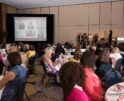
Karen Kerrigan, President & CEO, Small Business & Entrepreneurship Council

Obstacles? Bring It!
By Caroline Cox
Karen Kerrigan doesn’t let much slow her down. The mother of two not only founded the Small Business & Entrepreneurship Council but, in 2009, she continued to run it while undergoing chemo for Hodgkin’s lymphoma. She’s the go-to expert on governmental benefits for entrepreneurs and is constantly a voice for them in Congress. The fearless New York native manages a $2 million budget and forms collaborative relationships between businesses, the media, public policy groups and the government while advocating for women entrepreneurs around the globe.
Here, she talks to PINK about her chameleon-like leadership style, beating cancer and never letting an opportunity pass her by.
PINK: What’s the secret to your professional success?
Karen Kerrigan: I’ve always expected big things to happen in my life. I believe that attracts the type of people, opportunities and resources to make things happen. When I was thinking about starting the SBE Council, the idea was presented by a network of business and key political leaders who believed Washington needed a more grounded and aggressive voice for entrepreneurs. Of course, I needed to develop the business strategy and vision, but seed money was there once I proved I had the strategy and leadership ability to make it work.
Secondly, I was blessed with a fearlessness that allows me to bust through potential obstacles. Many in the established business community in Washington were not pleased with the SBE council’s disruptive presence, and some men let me know exactly how they felt. I shrugged it off and went about my work. In fact, I worked harder.
PINK: What are the biggest concerns women business owners are facing now?
KK: The state of the economy – the challenge of sustaining and growing revenues. Access to growth capital is a key issue that continues to hold promising women-owned businesses back. Staying competitive and relevant is difficult, even in good economic times. However, the barriers women face are sometimes self-limiting ones we place on ourselves. Women entrepreneurs are succeeding fabulously, but continuing the success and growth of women-owned firms requires a mindset where women should start their businesses with a plan for growth. That means knowing they need the financial acumen and tenacity to raise capital, and they can’t be afraid to do so.

PINK: What is the best business advice you’ve ever received?
KK: Don’t worry about things you can’t control.
PINK: Describe your leadership style.
KK: It varies depending upon the situation or the project. I have a highly skilled and motivated team, so it ranges from laissez faire to coaching. For example, certain projects or areas of operation require little oversight. Other projects require my deeper involvement, because the risks are high if we don’t produce solid work.
In Washington, credibility is extremely important. Because there can be no errors in the complex data we present or the daily communications and analysis we churn, I am very involved in the review and editing. My teams know there’s no task that is below me. When my leadership style turns to coaching, it’s done to help the personal development of a team member or to improve their method. Today’s leaders must have multiple leadership styles, and know when to use them.
PINK: How do you motivate and communicate with your team?
KK: We have five team members and several independent contractors. I motivate them by giving them a lot of freedom and input into their work. I trust them to get the job done, hit deadlines and keep me informed if things get off track. We practice workplace flexibility, and they’re comfortable requesting a change of schedule or to telecommute if they have family issues or events. We communicate when there is something that needs to get done, and we don’t have meetings just for the sake of having meetings. I hire people who are self-motivated, and my job is to not get in their way. There’s a division of labor, we agree to the timelines and no one lets the team down.
PINK: What is your biggest weakness as a leader?
KK: Taking on too many details of a project. Sometimes, it’s just hard to let go. I learn a lot if I take the lead on the media side, or to look at the marketing opportunities. Other times, maybe I stay involved in a project or take on an assignment because it’s a control issue. I’m learning, as women who run businesses learn, that to grow personally and for the organization to accomplish goals quicker, you have to let go and be less in control. I am getting better at that, but it’s something I’ve been grappling with most of my career.
PINK: How do you balance life and work?
KK: I prioritize in this order: God, family, health, work. I don’t consciously strive to reach balance, but I’m constantly reprioritizing tasks and what needs to be done to avoid severe stress. The key to balance is to know your limitations, like saying “no” to certain things and “yes” to others on a manageable scale.
PINK: What is it about your background that resulted in your choices and success today?
KK: I come from modest beginnings. I was raised in upstate New York, outside of Albany. My parents had five kids and worked for the state in middle class-type jobs. My siblings and I all had to work as soon as we were able, even if it was just babysitting or taking a summer job. There weren’t a lot of extra resources around. I’m always looking out for opportunities, and I don’t take anything for granted. I don’t think, “I’ll let these opportunities go by and more will come,” because that’s often not the case. I am grateful for everything I have, everything I’ve been given, and opportunities that have come my way.
PINK: How do you relax and rejuvenate yourself?
KK: I was a competitive tennis player and played in college all four years. I get on the court when I can, but that’s very difficult to do. Generally I run, walk and work in the yard. I try to run at least four times a week. When I’m feeling a little braver, I’ll play basketball with my daughter, who’s a very competitive player.
PINK: What’s one thing most people don’t know about you?
KK: In February 2009, I was diagnosed with Hodgkin’s lymphoma. When I was diagnosed, I read a lot about the disease, the treatment, and the success outcome percentage. After reading about the high success rate, I expected to get better. I did all the things I needed to do to put me on the path to healing: find good doctors and do things that would help me stay healthy, like exercising. Dealing with it in a very ‘business as usual’ manner helped me get through it. The technologies we have today allow us to go to our doctor’s office, get chemo, and be able to do teleconferences and work with Wi-Fi at the same time. Plus, thanks to major medical advances in anti-nausea medicine, I didn’t get sick once.
PINK: What was it like trying to work while going through chemo?
KK: They told me, “As treatment goes on with these powerful drugs, you may find yourself getting weaker and weaker.” I didn’t have any energy problem. The only issue I had was what they call “chemo brain,” when you seem a little foggy a couple of days after treatment. To me, it was just like not having a good night’s sleep. When you’ve got kids and you work – if you haven’t gotten a good night’s sleep, you still have to function the next day. A lot of women can relate to that. I thought, “I may not be able to do a radio interview or talk to the media, but there’s administrative stuff and a whole range of things I can do, even with this chemo brain.” No one at the office had any anxieties about what may happen with day-to-day stuff or problems that may arise, and that felt good. If you keep the ball rolling, everyone senses that and keeps moving forward as well.
PINK: Did you remain optimistic throughout treatment?
KK: There were certainly scary moments. You say to yourself, “Everything will be fine, I’ve read the numbers, I’ve read the statistics. There is an 85 to 95 percent chance of it going away, but what if I’m the 5 or 10 percent?” But for the most part, even when I got the diagnosis, I felt like this was something I could and would overcome. I had total trust in the drugs, the doctors, and my ability to fight through it and any of the negative effects it would have. I have a lot of people who were very supportive and a ton of people praying for me. I think that made all the difference. I was in treatment through August 2009, and my recent CAT scan from September showed I was still clear.
PINK: What is one personal goal you haven’t yet achieved?
KK: Writing a book. I have a new idea each week and can’t seem to stick to one concept.
PINK: How do you define success?
KK: Living the dream, seeing your kids happy, giving back and helping others.
Recommended
-
Do You Have The Imposter Syndr...June 18th, 2022
-
1 Key Email Marketing Tips For...January 6th, 2022
-
Six Tips For Choosing A PEO Se...September 20th, 2021
-
Top Women Profiles, PINK Lists...July 20th, 2021
-
Black Lives Matter. PINK Stand...June 15th, 2020















